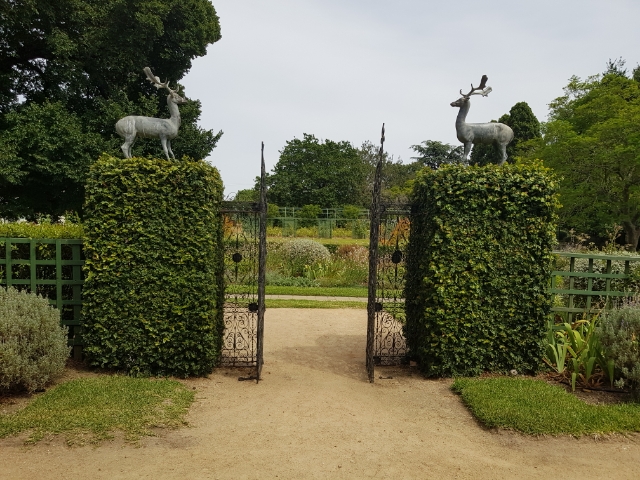Learn English while learning about daily life in Australia, with Rob McCormack
Podcast Number 136 – Dame Nellie Melba – Australia’s First Opera Star
(This podcast is 16 minutes and 35 seconds long.)
Hi,
One regional highway that I ride my motorcycle on quite often here in Victoria is the Melba Highway. It goes for 65 kilometres from the outer Melbourne suburb of Coldstream to the small regional town of Yea, north of Melbourne. It is named after a great Australian, Dame Nellie Melba, an opera singer born in Melbourne in 1861. In this podcast, I would like to tell you a little about her remarkable life and achievements.
Helen (Nellie) Porter Mitchell, later to be known as Dame Nellie Melba, was born in Richmond in Victoria in 1861. Her parents were both lovers of music and her mother played the piano, harp and organ. As a small child, Nellie learnt to play the piano and loved to sing. Her father was a builder and also a farmer and owned several properties in country Victoria. Nellie grew up experiencing and loving country life and doing outdoor activities, but her great love was music and in particular singing. She studied these at the school which she attended, the Presbyterian Ladies College, which still exists today. Her passion for opera was evident even as a teenager. It is said that she even learned by heart the words of operas in foreign languages.
At the age of 8 she received her first review in the press, when The Australian newspaper reported on her piano playing and singing at a fund raising concert in Richmond. They wrote she was ‘the ‘gem’ of the evening, and richly deserved the spontaneous encore she received’ (The Australian, Saturday December 11, 1869). When she left school, she continued her study of music by taking singing lessons with an Italian born singing teacher in Melbourne.
At the age of 20 her life took an unexpected turn when her mother died suddenly in 1881, followed by her youngest sister just 3 months later. Not long after these tragic events, her father decided to take Nellie with him on an extended business visit to Queensland. There Nellie met a dashing young man called Charles Armstrong, a capable horseman. A romance blossomed and soon they were married. But the marriage was not a good one. Within a year her first and only child George was born, but that failed to save the marriage, as Nellie was extremely unhappy. She decided to return to Melbourne. The lonely life in the hot climate of country Queensland was not for her. Her passion was for opera singing.
Once back in Melbourne with her father and her son, she was able to continue with singing lessons and started to perform at concerts. For the first time she was able to earn some income as a singer. This made her more determined than ever to travel to Europe and fulfill her dream of becoming an opera singer.
Her chance came when her father accepted a short term job in London and invited Nellie to go with him, along with her estranged husband. Nellie’s father hoped that the trip might bring them back together as a couple. They left for London in March 1886. Little did she know that it would be 16 years before she would return to Australia. Once in London she tried her luck with various music teachers, hoping to impress them with her skills. However, she was one of many singers looking for opportunities and she had limited luck in getting noticed in London. Her final chance came with a well-known singing teacher in Paris, Mathilde Marchesi, with whom she managed to arrange a meeting. When she sang for Madame Marchesi, her talent was finally recognized. Madame Marchesi was reported to have said, ‘At last I have found a star!’
Nellie became her student and was soon studying hard and training her voice with her new teacher. She was also given the opportunity to perform in concerts, although not in operas as yet. It was at this time that Nellie decided to use a stage name instead of her real surname. The stage name she selected was Melba, a shortened form of her home town – Melbourne. Thereafter she was called Nellie Melba. As word spread about Nellie’s talent, she was finally given the chance to sing in her first opera in Brussels. It is remarkable that Nellie was able to do this while also looking after her young son in an unfamiliar city like Paris.
In October 1887, Nellie made her debut as an opera singer at the Theatre de la Monnaie in Brussels in Belgium. She played the role of Gilda in the opera Rigoletto, by Verdi. Her performance was an instant success. In the royal box watching the performance was the Queen of Belgium, who asked to meet Nellie after her performance. She told Nellie ‘You are wonderful.’ Nellie became a star overnight, receiving praise and compliments for her performance. Her voice was described as unique in quality, with a perfect technique.
Her career from there went from strength to strength. She sang in Covent Garden in London, the Paris Opera and extensively in New York at the Metropolitan Opera. She sang for kings and queens all over Europe. Over the next 15 years she became one of the greatest and most popular opera singers of the time, arguably one of the most famous women in the world at that time.
In 1902 she returned triumphantly to Australia and undertook a tour lasting 2 years around all parts of Australia and New Zealand. It was during this tour that Australians came to know and love this unique Australian. After 6 more years starring in operas in Europe and America she returned once again to tour in Australia in 1909, including performing concerts in many small country towns in New South Wales and Queensland.
In November 1909 she purchased a 60 acre farm at Coldstream, a small village just outside Melbourne, where she decided to build a home and garden for herself and for George her son. She called it Coombe Cottage and it is still owned by her family today.
Luckily it is open for tourists and visitors. My wife and I spent a few hours there recently. We did a guided tour of the gardens and had coffee and scones in the café.
It was great to learn more about Nellie Melba. For example, we learned that she loved to drive and was one of the first women to get her driving licence in Victoria. In her garage at Coombe Cottage she had a number of cars, including a Rolls Royce, a Renault, a Fiat and a Cadillac. We also learned that she loved to put on lavish parties for the rich and famous of Victorian Society. She would organize a special train to bring her guests from the city to the Coldstream station, where she would have them picked up by cars and brought back to Coombe Cottage where the gardens had been brilliantly decorated for the party. The newspapers on the following day would report the details of the wonderful dresses and gowns worn by the women party goers. It seems that Nellie Melba not only knew how to sing opera, but also how to have a good time!
From 1909 to 1914 she toured not only in Australia but also Great Britain, America and Canada, including concerts in many smaller towns and cities. She liked to share her talents with people from all parts of society.
During the First World War from 1914 to 1918, her European opera singing stopped and she stayed mostly in Australia, with some trips to Canada and America. She helped to raise money for the war effort, raising more than 100,000 pounds, which in today’s money would be many millions of dollars. In 1918 she was given a Royal Honour and made a Dame, which is the female equivalent of a knighthood (Sir). Thereafter she was called Dame Nellie Melba. In 1927, when the new national parliament building for Australia was opened in Canberra, Dame Nellie Melba was asked to sing the national anthem.
Dame Nellie Melba performed her last concert in 1928 in Australia and her last public performance was in England in 1929. She passed away on February the 23rd, 1931 at the age of 69. News of her death was reported on the front pages of newspapers both in Australia and around the world. Her funeral was a major event in Melbourne, with thousands of people lining the streets to pay their respects.
Even today, almost 100 years after her death, she is well known by most Australians. Thousands visit her home and gardens at Coombe Cottage in outer Melbourne each year. I would say Dame Nellie Melba was one of the first and most successful independent women of Australia, long before feminism even became a concept. Dame Nellie’s picture appears on the Australian $100 note and that seems totally appropriate, as far as I am concerned.
If you have a question or a comment to make, please leave it in the comments box at the bottom of this page. Or, you can send me an email at rob@slowenglish.info. I would love to hear from you. Tell me where you live, a little bit about yourself and what you think of my Slow English podcast. I will write back to you, in English of course. If you would like to take a short quiz to see if you have understood this podcast, you will also find it on my website. Goodbye until next time.
Rob
Podcast 136 Quiz - Did you understand the podcast?
You can take the quiz as many times as you like.
Vocabulary
achievements = the good things you have done
acre = an old measure of area, equal to about 24 hectares
appropriate = correct
arguably = people can give good reasons why something is true
as far as I am concerned = in my opinion, from my perspective, from my viewpoint
attended = visited or went to
blossomed = (here) grew (usually used with flowers, but also can be used with other things, eg romance)
Brussels = the capital city of Belgium
capable = able to do things easily
compliments = nice things that people might say about you or your performance
concept = an idea about something
concerts = where actors or musicians perform in front of an audience
country = away from the cities
dashing = a way to describe a man who is good looking, adventurous, confident
debut = the first time you do something in front of others
decorated = things which make something else look better, e.g. ribbons, lights etc
determined = when you really want to do something a lot
driving licence = shows that you are allowed to drive a car
encore = to ask a performer to play or sing another song
estranged = when a husband or wife no longer lives with their partner
evident = can be seen
exists = is still there
extended = made longer
extensively = over a wide area or over a long period of time
extremely = very much, a lot
feminism = a movement seeking equal rights and opportunities for women
foreign = from an overseas country
fulfill = make into a reality, to make it come true
fund raising = to ask people for money for a good cause
gowns = long women’s dresses which go down to their feet
harp = a type of musical instrument where the player pulls the strings with their fingers
impress = to show someone else that you are very, very good
in particular = when talking about one thing or one group of things
income = the money that you earn in your job
independent = does not need anyone else to look after them
lavish = of very high quality, usually luxurious, of a very high standard
learned by heart = to learn something very, very well
limited = very few, very little
noticed = (here) when you are seen by others
opera = a type of theatre play where the actors sing their words
opportunities = when you have a chance to do something, when you have an option
organ = a type of musical instrument with pipes into which air is blown
passion = when you really love doing something
pay their respects = to show someone that you like what they have done, that you respect them
press = newspapers and the journalists who work there
properties = buildings, usually more than just a house, including the land
purchased = bought
recognized = when others can see you or can see what your talents are
regional = away from the cities
remarkable = special, of high quality
review = (here) when someone says how good or bad your performance is
romance = when a man and a woman (or same sex couple) love one another
royal box = this is a special place at the theatre or opera house for the royal family to sit
Royal Honour = a compliment or award given by the king or queen
scones = a type of sweet bun
short term = not for a long time (e.g. for a few months only)
spontaneous = when something happens immediately, without planning
stage name = a made up name which actors or musicians use instead of their real name
strength to strength = to get stronger and stronger, to get better and better
technique = how you do something, the way you do it
tragic = very, very bad, usually when someone dies
triumphantly = how you feel after you have won or have done very well
turn = (here) a change
unfamiliar = when you don’t know much about something or someone
unique = there is nothing else like it
war effort = all the things you must do to win a war




